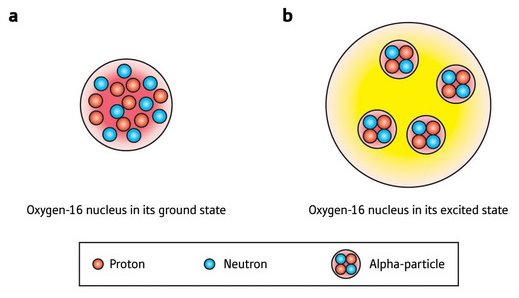Dec. 19, 2008 Research Highlight Physics / Astronomy
Nuclear condensation
The excited energy state of an oxygen nucleus could consist of a condensate of alpha particles
 Figure 1: Structure of atomic nuclei. (a) In the ground state, the protons and neutrons of an oxygen-16 nucleus jostle randomly like the molecules of a liquid. (b) In the excited state, the calculations of Funaki and colleagues suggest these protons and neutrons cluster together to form four alpha particles. Moreover, these alpha-particles can themselves condense into a single quantum state, similar to that of a conventional Bose–Einstein condensate.
Figure 1: Structure of atomic nuclei. (a) In the ground state, the protons and neutrons of an oxygen-16 nucleus jostle randomly like the molecules of a liquid. (b) In the excited state, the calculations of Funaki and colleagues suggest these protons and neutrons cluster together to form four alpha particles. Moreover, these alpha-particles can themselves condense into a single quantum state, similar to that of a conventional Bose–Einstein condensate.
Our understanding of the electronic structure of atoms has changed very little since the development of quantum mechanics almost three-quarters of a century ago. And with the completion of the Large Hadron Collider at CERN, Switzerland, it is expected that the final elements of the Standard Model of particle physics will soon be confirmed. Yet, surprisingly little is known about the behavior of atomic nuclei at the scale between atoms and subatomic particles.
To better understand the processes that determine the behavior of atomic nuclei, Yasuro Funaki of the RIKEN Nishina Center for Accelerator-Based Science, Wako, and his colleagues in Japan, Germany and France, have performed state-of-the-art calculations to test the theory that the particles within an oxygen nucleus could coalesce together to form an unusual quantum state of low nuclear density, known as a Bose–Einstein condensate1.
The protons and neutrons of an atomic nucleus in its lowest energy state are believed behave in a manner similar to molecules of a simple liquid with no defined structure (Fig. 1a). At energies above the ground state, however, some order can emerge. The protons and neutrons within a carbon-12 nucleus, for example, can arrange into tightly bound clusters of three alpha-particles, consisting of two protons and two neutrons each. Such clustering plays an important role in the creation of elements in stars, and is believed to be the principle means by which carbon nuclei form.
In previous work, Funaki and colleagues investigated the mechanisms by which the alpha-particles within a carbon-12 nucleus might interact2. As well as confirming the formation of an excited state consisting of three alpha particles with a nuclear density four times lower than the ground state, their calculations suggested that these particles might themselves coalesce into a Bose–Einstein condensate.
In this unusual form of matter, the constituent particles of a system all occupy exactly the same quantum state. Bose–Einstein condensates are mostly commonly observed to emerge when a dilute atomic gas of certain elements is cooled to a temperature close to absolute zero. Although this state was predicted early last century, and demonstrated in 1995, it was only suggested recently that it might arise within atomic nuclei and other nuclear systems, such as collapsing stars.
In their latest work, the researchers turn their attention to oxygen-16, the next nucleus above carbon-12 to support a condensed system of alpha particles (Fig. 1b). Their calculations suggest that such a state forms at energies consistent with experimental observations.
References
- 1. Funaki, Y., Yamada, T., Horiuchi, H., Röpke, G., Schuck, P. & Tohsaki, A. α-particle condensation in 16O studied with a full four-body orthogonality condition model calculation. Physical Review Letters 101, 082502 (2008). doi: 10.1103/PhysRevLett.101.082502
- 2. Funaki, Y., Tohsaki, A., Horiuchi, H., Schuck, P. & Röpke, G. Analysis of previous microscopic calculations for the second 0+ state in 12C in terms of 3-α particle Bose-condensed state. Physical Review C 67, 051306 (2003). doi: 10.1103/PhysRevC.67.051306
